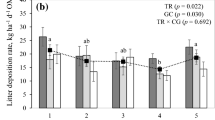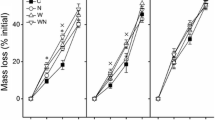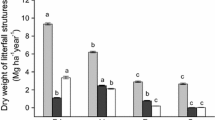Abstract
This study hypothesized that the deposition and decomposition of the litter from the legume tree Mimosa caesalpiniifolia Benth. could improve and accelerate nutrient cycling in a tropical pasture (Urochloa decumbens Stapf.) under a silvopastoral system. The objective of this study was to evaluate litter deposition, chemical composition, and decomposition of the legume tree M. caesalpiniifolia. Treatments included a silvopastoral system with signalgrass (U. decumbens) combined with the legume tree M. caesalpiniifolia, and monocropping systems of both species, in a randomized complete block design with three replications. It was evaluated litter deposition from legume trees over two years. A decomposition assay evaluated leaf decay of the legume and grass (0 to 512 days), incubated under different cropping systems (silvopastoral and monoculture), and at different distances away from the legume trees (0 and 2 m). Greater litterfall was recorded in the legume tree monoculture system (534 kg ha− 1) and during the dry season (541 kg ha− 1) (p < 0.05). The silvopasture system induced N release from the grass litter under decay. After 512 days, incubated grass leaves still had 30% of decaying material, while the legume had about 39%. The remaining N in the litter increased, and the C and C/N ratio decreased over the incubation period. Legume trees have the potential to diversify nutrient cycling in tropical pastures, due to high N and lignin content, and low C/N ratio compared to grass. The presence of legume trees can create zones with different nutrient return rates along the pasture.



Similar content being viewed by others
Data Availability
The data that support the findings of this study are available on request from the corresponding author.
References
Abreu LHG, de Freitas IC, Santana PHL, de Almeida Barbosa DL, Santos LDT, Santos MV, Sanglard DA, Frazão LA (2020) Variation in soil carbon, nitrogen and microbial attributes within a silvopastoral system in the Brazilian Cerrado. Agrofor Syst 94:2343–2353. https://doi.org/10.1007/s10457-020-00554-x
Apolinário VXO, Dubeux JCB, Mello ACL, Vendramini JMB, Lira MA, Santos MVF, Muir JP (2014) Litter decomposition of signalgrass grazed with different stocking rates and nitrogen fertilizer levels. Agron J 106:622–627. https://doi.org/10.2134/agronj2013.0496
Apolinário VXO, Dubeux JCB, Lira MA, Ferreira RLC, Mello ACL, Santos MVF, Sampaio EVSB, Muir JP (2015) Tree legumes provide marketable wood and add nitrogen in warm-climate silvopasture systems. Agron J 107:1915–1921. https://doi.org/10.2134/agronj14.0624
Apolinário VX, de O, Dubeux JCB, Lira M, de Sampaio A, de Amorim EVSB, e Silva SO, de Muir NG JP (2016a) Arboreal legume litter nutrient contribution to a tropical silvopasture. Agron J 108:2478–2484. https://doi.org/10.2134/agronj2016.02.0120
Apolinário VXO, Dubeux JCB, Lira MA, Ferreira RLC, Mello ACL, Coelho DL, Muir JP, Sampaio EVSB (2016b) Decomposition of arboreal legume fractions in a Silvopastoral system. Crop Sci 56:1356–1363. https://doi.org/10.2135/cropsci2015.09.0588
Association of Official Analytical Chemists– AOAC (2000) Official methods of analysis. AOAC, Gaithersburg, MD, USA
Bayala J, Prieto I (2020) Water acquisition, sharing and redistribution by roots: applications to agroforestry systems. Plant Soil 453:17–28. https://doi.org/10.1007/s11104-019-04173-z
Bezerra Neto E, Barreto LP (2011) Análises químicas e bioquímicas em plantas. Editora Universitária da UFRPE, Recife. (Portuguese)
Camelo D, Dubeux JCB, Dos Santos MVF, Lira MA, Fracetto GGM, Fracetto FJC, da Cunha MV, de Freitas EV (2021) Soil microbial activity and biomass in semiarid agroforestry systems integrating forage cactus and tree legumes. Agronomy 11:1558. https://doi.org/10.3390/agronomy11081558
Cardinael R, Mao Z, Chenu C, Hinsinger P (2020) Belowground functioning of agroforestry systems: recent advances and perspectives. Plant Soil 453:1–13. https://doi.org/10.1007/s11104-020-04633-x
Cassart B, Angbonga Basia A, Jonard M, Ponette Q (2020) Average leaf litter quality drives the decomposition of single-species, mixed-species and transplanted leaf litters for two contrasting tropical forest types in the Congo Basin (DRC). Ann Sci 77:1–20. https://doi.org/10.1007/s13595-020-00942-4
Chen C, Liu W, Jiang X, Wu J (2017) Effects of rubber-based agroforestry systems on soil aggregation and associated soil organic carbon: implications for land use. Geoderma 299:13–24. https://doi.org/10.1016/j.geoderma.2017.03.021
Costa AN, Souza JR, Alves KM, Penna-Oliveira A, Paula-Silva G, Becker IS, Marinho-Vieira K, Bonfim AL, Bartimachi A, Vieira-Neto EHM (2020) Linking the spatiotemporal variation of litterfall to standing vegetation biomass in Brazilian savannas. J Plant Ecol 13:517–524. https://doi.org/10.1093/jpe/rtaa039
De Beeck MO, Persson P, Tunlid A (2021) Fungal extracellular polymeric substance matrices– highly specialized microenvironments that allow fungi to control soil organic matter decomposition reactions. Soil Biol Biochem 159:108304. https://doi.org/10.1016/j.soilbio.2021.108304
Dubeux JCB, Sollenberger LE, Vendramini JMB, Stewart RL, Interrante SM (2006) Litter mass, deposition rate, and chemical composition in bahiagrass pastures managed at different intensities. Crop Sci 46:1299–1304. https://doi.org/10.2135/cropsci2005.08-0262
Dubeux Junior JCB, Muir JP, Apolinário VX, de Nair O, Lira PKR, de Sollenberger M LE (2017) Tree legumes: an underexploited resource in warm-climate silvopastures. Rev Bras Zootec 46:689–703. https://doi.org/10.1590/S1806-92902017000800010
Espig SA, Freire FJ, Marangon LC, Ferreira RLC, Freire MBG dos S, Espig DB (2009) Sazonalidade, composição e aporte de nutrientes da serapilheira em fragmento de Mata Atlântica. Rev Árvore 33:949–956. https://doi.org/10.1590/s0100-67622009000500017
Freire JDL, Dubeux Júnior JCB, Lira MDA, Ferreira RLC, Santos MVF, Freitas EVD (2010) Litter decomposition under a sabiá canopy in the Forest Zone in Pernambuco. R Bras Zootec 39:1659–1665. https://doi.org/10.1590/S1516-35982010000800006
González-M. R, Norden N, Posada JM, et al (2019) Climate severity and land-cover transformation determine plant community attributes in Colombian dry forests. Biotropica 51:826?837.https://doi.org/10.1111/btp.12715
Helal GA, Khalil RR, Galal YG, Soliman SM, Abd Elkader RS (2022) Studies on cellulases of some cellulose-degrading soil fungi. Arch Microbiol 204:65. https://doi.org/10.1007/s00203-021-02705-9
Herrera AM, de Mello ACL, Apolinário VX, de O, Dubeux Júnior JCB, da Silva VJ, dos Santos MVF, da Cunha MV (2020) Decomposition of senescent leaves of signalgrass (Urochloa decumbens Stapf. R. Webster) and arboreal legumes in silvopastoral systems. Agrofor Syst 94:2213–2224. https://doi.org/10.1007/s10457-020-00542-1
Herrera Angulo AM, De Mello ACL, Apolinário VX, de O, Dubeux JCB Jr, Mora RE, De Freitas EV (2023) Soil fertility in silvopastoral systems integrating tree legumes with signalgrass (Urochloa decumbens Stapf. R. Webster). Arch Latinoam Prod Anim 31:287–298. https://doi.org/10.53588/alpa.310401
Hou SL, Hättenschwiler S, Yang JJ, Sistla S, Wei HW, Zhang ZW, Hu YY, Wang RZ, Cui SY, Xiao-Tao L, Han XG (2021) Increasing rates of long-term nitrogen deposition consistently increased litter decomposition in a semi-arid grassland. New Phytol 229:296–307. https://doi.org/10.1111/nph.16854
IUSS Working Group. World Reference Base for Soil Resources (2014) International soil classification system for naming soils and creating legends for soil maps. World Soil Resources Reports, 106, 2014
Kassa G, Bekele T, Demissew S, Abebe T (2022) Leaves litterfall and nutrient inputs from four multipurpose tree/shrub species of homegarden agroforestry systems. Environ Syst Res 11:29. https://doi.org/10.1186/s40068-022-00278-0
Kebede E (2021) Contribution, utilization, and improvement of Legumes-Driven Biological Nitrogen fixation in Agricultural systems. Front Sustain Food Syst 5:767998. https://doi.org/10.3389/fsufs.2021.767998
Kim DG, Isaac ME (2022) Nitrogen dynamics in agroforestry systems. A review. Agron Sustain Dev 42:60. https://doi.org/10.1007/s13593-022-00791-7
Klotzbücher T, Kaiser K, Guggenberger G, Gatzek C, Kalbitz K (2011) A new conceptual model for the fate of lignin in decomposing plant litter. Ecology 92:1052–1062. https://doi.org/10.1890/10-1307.1
Krishna MP, Mohan M (2017) Litter decomposition in forest ecosystems: a review. Energy Ecol Environ 2:236–249. https://doi.org/10.1007/s40974-017-0064-9
Kulmatiski A, Beard KH (2013) Root niche partitioning among grasses, saplings, and trees measured using a tracer technique. Oecologia 171:25–37. https://doi.org/10.1007/s00442-012-2390-0
Lebrazi S, Fikri-Benbrahim K (2022) Potential of tree legumes in agroforestry systems and soil conservation. Advances in Legumes for sustainable intensification. Elsevier, pp 461–482
Lima HNB, Dubeux JC, dos Santos MVF, de Mello ACL, Lira MA, Cunha MV (2016) Decomposition of cattle dung on grazed signalgrass (Brachiaria decumbens Stapf) pastures in monoculture or intercropped with tree legumes. Afr J Range Forage Sci 33:119–126. https://doi.org/10.2989/10220119.2016.1158737
Lira Junior MA, Fracetto FJC, Ferreira JdaS, Silva MB, Fracetto GGM (2020) Legume silvopastoral systems enhance soil organic matter quality in a subhumid tropical environment. Soil Sci Soc Am J 84:1209–1218. https://doi.org/10.1002/saj2.20106
Littell RC, Henry PR, Ammerman CB (1998) Statistical analysis of repeated measures data using SAS procedures. J Anim Sci 76:1216–1231. https://doi.org/10.2527/1998.7641216x
Liu N, Kan HM, Yang GW, Zhang YJ (2015) Changes in plant, soil, and microbes in a typical steppe from simulated grazing: explaining potential change in soil C. Ecol Monogr 85:269–286. https://doi.org/10.1890/14-1368.1
Liu L, Huang WC, Liu Y, Li M (2021) Diversity of cellulolytic microorganisms and microbial cellulases. Int Biodeterior Biodegrad 163:105277. https://doi.org/10.1016/j.ibiod.2021.105277
Luske B, van Eekeren N (2018) Nutritional potential of fodder trees on clay and sandy soils. Agrofor Syst 92:975–986. https://doi.org/10.1007/s10457-017-0180-8
Maillard A, Diquélou S, Billard V, Laîné P, Garnica M, Prudent M, Garcia-Mina JM, Yvin JC, Ourry A (2015) Leaf mineral nutrient remobilization during leaf senescence and modulation by nutrient deficiency. Front Plant Sci 6:1–15. https://doi.org/10.3389/fpls.2015.00317
Martínez-Atencia J, Loaiza-Usuga JC, Osorio-Vega NW, Correa-Londoño G, Casamitjana-Causa M (2020) Leaf Litter Decomposition in Diverse Silvopastoral systems in a neotropical environment. J Sustain for 39:710–729. https://doi.org/10.1080/10549811.2020.1723112
Martínez-García LB, Korthals GW, Brussaard L, Mainardi G, De Deyn GB (2021) Litter quality drives nitrogen release, and agricultural management (organic vs. conventional) drives carbon loss during litter decomposition in agro-ecosystems. Soil Biol Biochem 153:108115. https://doi.org/10.1016/j.soilbio.2020.108115
Miqueloto T, Winter FL, Bernardon A, Cavalcanti HS, de Medeiros Neto C, Martins CDM, Sbrissia AF (2020) Canopy structure of mixed kikuyugrass–tall fescue pastures in response to grazing management. Crop Sci 60:499–506. https://doi.org/10.1002/csc2.20005
Morffi-Mestre H, Ángeles-Pérez G, Powers JS, Andrade JL, Ruiz AHH, May-Pat F, Chi-May F, Dupuy JM (2020) Multiple factors influence seasonal and interannual litterfall production in a tropical dry forest in mexico. Forests 11:1–23. https://doi.org/10.3390/f11121241
Mott GO, Lucas HL (1952) The design, conduct, and interpretation of grazing trials on cultivated and improved pastures. In: International Grassland Congress. Pensylvania, pp 1380–1385
Moura EG, Carvalho CS, Bucher CPC, Souza JLB, Aguiar ACF, Ferraz ASL, Bucher CA, Coelho KP (2020) Diversity of rhizobia and importance of their interactions with legume trees for feasibility and sustainability of the tropical agrosystems. Diversity 12:206. https://doi.org/10.3390/D12050206
Naeem I, Wu X, Asif T, Wang L, Wang D (2022) Livestock diversification implicitly affects litter decomposition depending on altered soil properties and plant litter quality in a meadow steppe. Plant Soil 473:49–62. https://doi.org/10.1007/s11104-021-05006-8
Padalia K, Parihaar R, Bhakuni N, Kapkoti B (2015) Leaf Litter decomposition of two Central Himalayan oaks. Curr World Environ 10:509–516. https://doi.org/10.12944/cwe.10.2.16
Pessoa DV, Pereira de Andrade A, Rodrigues Magalhães AL, Teodoro AL, Cordeiro dos Santos D, Leal de Araújo GG, Nunes de Medeiros A, Bezerra do Nascimento D, de Lima Valença R, Cardoso DB (2020) Forage cactus of the genus Opuntia in different with the phenological phase: nutritional value. J Arid Environ 181:104243. https://doi.org/10.1016/j.jaridenv.2020.104243
Primo AA, Araújo MDM, Silva K da, Silva F, Pereira LA, de AC G, Fernandes FÉP, Pompeu RCFF, Natale W, de Souza HA (2021) Litter production and nutrient deposition from native woody species in the Brazilian semi-arid region. Agrofor Syst 95:1459–1464. https://doi.org/10.1007/s10457-021-00652-4
Saj S, Nijmeijer A, Nieboukaho JDE, Lauri PE, Harmand JM (2021) Litterfall seasonal dynamics and leaf-litter turnover in cocoa agroforests established on past forest lands or savannah. Agrofor Syst 95:599. https://doi.org/10.1007/s10457-021-00615-9
Santos HG, Jacomine PKT, Anjos LHC, Oliveira VA, Lumbrera SJF, Coelho MR, Almeida JA, Araújo Filho JC, Oliveira JB, Cunha TJF (2018) Sistema brasileiro de classificação de solos. Brasília, DF: Embrapa, 2018. (Portuguese)
Sari RR, Rozendaal DMA, Saputra DD, Hairiah K, Roshetko JM, van Noordwijk M (2022) Balancing litterfall and decomposition in cacao agroforestry systems. Plant Soil 473:251–271. https://doi.org/10.1007/s11104-021-05279-z
Senger CCD, Kozloski GV, Bonnecarrère Sanchez LM, Mesquita FR, Alves TP, Castagnino DS (2008) Evaluation of autoclave procedures for fibre analysis in forage and concentrate feedstuffs. Anim Feed Sci Technol 146:169–174. https://doi.org/10.1016/j.anifeedsci.2007.12.008
Shinde R, Shahi DK, Mahapatra P, Naik SK, Thombare N, Singh AK (2022) Potential of lignocellulose degrading microorganisms for agricultural residue decomposition in soil: a review. J Environ Manage 320:115843. https://doi.org/10.1016/j.jenvman.2022.115843
Siqueira DP, de Carvalho GCMW, de Souza Silva JG, Caldeira MVW, Barroso DG (2022) Litter decomposition and nutrient release for two tropical N-fixing species in Rio De Janeiro, Brazil. J Res 33:487–496. https://doi.org/10.1007/s11676-021-01383-z
Sollenberger LE, Moore JE, Allen VG, Pedreira CGS (2005) Reporting forage allowance in grazing experiments. Crop Sci 45:896–900. https://doi.org/10.2135/cropsci2004.0216
Steinfeld JP, Miatton M, Creamer RE, Ehbrecht M, Valencia V, Ballester MVR, Bianchi FJJA (2024) Identifying agroforestry characteristics for enhanced nutrient cycling potential in Brazil. Agric Ecosyst Environ 362:108828. https://doi.org/10.1016/j.agee.2023.108828
Su Y, Dong K, Wang C, Liu X (2022) Grazing promoted plant litter decomposition and nutrient release: a meta-analysis. Agric Ecosyst Environ 337:108051. https://doi.org/10.1016/j.agee.2022.108051
Teixeira PC, Donagemma GK, Fontana A, Teixeira WG (2017) Manual de métodos de análise de solo. Embrapa, vol 3. Embrapa, Brasília, p 573. (Portuguese)
Udawatta RP, Rankoth LM, Jose S (2021) Agroforestry for biodiversity conservation. Agrofor Ecosyst Serv 245–274. https://doi.org/10.1007/978-3-030-80060-4_10
Uribe MR, Sierra CA, Dukes JS (2021) Seasonality of Tropical Photosynthesis: a pantropical map of correlations with precipitation and Radiation and comparison to Model outputs. J Geophys Res Biogeosciences 126. https://doi.org/10.1029/2020JG006123. e2020JG006123
Van Soest PJ, Robertson JB, Lewis BA (1991) Methods for Dietary Fiber, Neutral Detergent Fiber, and Nonstarch polysaccharides in Relation to Animal Nutrition. J Dairy Sci 74:3583–3597. https://doi.org/10.3168/jds.S0022-0302(91)78551-2
Verma A, Kumar P, Soni ML, Pawar N, Pradhan U, Tanwar SPS, Kumar S (2022) Litter production and litter dynamics in different agroforestry systems in the arid western region of India. Biol Agric Hortic 38:40–60. https://doi.org/10.1080/01448765.2021.1971110
Virk AL, Lin BJ, Kan ZR, Qi JY, Dang YP, Lal R, Zhao X, Zhang HL (2022) Simultaneous effects of legume cultivation on carbon and nitrogen accumulation in soil. Adv Agron 171:75–110. https://doi.org/10.1016/bs.agron.2021.08.002
Vongcharoen K, Santanoo S, Banterng P, Jogloy S, Vorasoot N, Theerakulpisut P (2018) Seasonal variation in photosynthesis performance of cassava at two different growth stages under irrigated and rain-fed conditions in a tropical savanna climate. Photosynthetica 56:1398–1413. https://doi.org/10.1007/s11099-018-0849-x
Wang Y, Li FY, Liu Y, Cheng J, Wang Y, Liu J, Wang X, Li Y (2023) Herbivore Dung promotes Plant Litter Decomposition Rate in a semi-arid Grassland Ecosystem. Ecosystems 26:661–674. https://doi.org/10.1007/s10021-022-00784-3
Wei Y, Wei B, Ryo M, Bi Y, Sun X, Zhang Y, Liu N (2023) Grazing facilitates litter-derived soil organic carbon formation in grasslands by fostering microbial involvement through microenvironment modification. CATENA 232:107389. https://doi.org/10.1016/j.catena.2023.107389
Xu H, Huang X, Chen J, Chen Y, Wang Y, Wu X, Wang J, He H, Dang P, Liu T, He X, Yan W (2023) Intercropping with legumes alleviates soil N limitation but aggravates P limitation in a degraded agroecosystem as shown by ecoenzymatic stoichiometry. Soil Biol Biochem 187:109210. https://doi.org/10.1016/j.soilbio.2023.109210
Zheng H, Yang T, Bao Y, He P, Yang K, Mei X, Wei Z, Xu Y, Shen Q, Banerjee S (2021) Network analysis and subsequent culturing reveal keystone taxa involved in microbial litter decomposition dynamics. Soil Biol Biochem 157:108230. https://doi.org/10.1016/j.soilbio.2021.108230
Zhou G, Chang D, Gao S, Liang T, Liu R, Cao W (2021) Co-incorporating leguminous green manure and rice straw drives the synergistic release of carbon and nitrogen, increases hydrolase activities, and changes the composition of main microbial groups. Biol Fertil Soils 57:547–561. https://doi.org/10.1007/s00374-021-01547-3
Acknowledgements
We thank the Fundação de Amparo à Ciência e Tecnologia do Estado de Pernambuco (FACEPE), Coordenação de Aperfeiçoamento de Pessoal de Nível Superior (CAPES), and Fundação de Amparo à Pesquisa e ao Desenvolvimento Científico e Tecnológico do Maranhão/ Conselho Nacional de Desenvolvimento Científico e Tecnológico for scholarship grants. Conselho Nacional de Desenvolvimento Científico e Tecnológico (CNPq) and FAPEMA for the postdoctoral scholarship 300634/2023-4.
Funding
This research was funded by the Fundação de Amparo a Ciência e Tecnologia do Estado de Pernambuco (FACEPE) (Code 117650414)-Recife, PE, Brazil, and partially by the National. The author Diana Valadares Pessoa received a scholarship from the Coordenação de Aperfeiçoamento de Pessoal de Nível Superior (CAPES) (Code 001), Brazil. Conselho Nacional de Desenvolvimento Científico e Tecnológico (CNPq) (scholarship 300634/2023-4), and Fundação de Amparo à Pesquisa e ao Desenvolvimento Científico e Tecnológico do Maranhão (FAPEMA) (PDCTR-08834/22). Alexandre Carneiro Leão de Mello, Márcio Vieira da Cunha and Mércia Virginia Ferreira dos Santos are CNPq-scholar.
Author information
Authors and Affiliations
Contributions
Diana Valadares Pessoa: setting up the experiment, collecting data, laboratory analysis, tabulating and writing the text; Marcio Vieira da Cunha: project administration, fundraising, statistical data analysis, conceptualization, and supervision; Alexandre Carneiro Le?o de Mello: project administration, fundraising, conceptualization, and supervision; M?rcia Virginia Ferreira dos Santos: project administration, fundraising, conceptualization, and supervision; G?ssica Solanna Calado Soares: Experiment setup, data collection, laboratory analysis; Dayanne Camello: Experiment setup, data collection, laboratory analysis; Val?ria Xavier de Oliveira Apolin?rio: Writing correction and formal analysis; Jos? Carlos Batista Dubeux Junior: project administration, fundraising, conceptualization, and supervision; Janerson Jos? Coelho: Writing correction and formal analysis.
Ethics declarations
Competing Interests
The authors declare that they have no known competing financial interests or personal relationships that may have influenced the work reported in this article.
Additional information
Publisher’s Note
Springer Nature remains neutral with regard to jurisdictional claims in published maps and institutional affiliations.
Electronic Supplementary Material
Below is the link to the electronic supplementary material.
Rights and permissions
Springer Nature or its licensor (e.g. a society or other partner) holds exclusive rights to this article under a publishing agreement with the author(s) or other rightsholder(s); author self-archiving of the accepted manuscript version of this article is solely governed by the terms of such publishing agreement and applicable law.
About this article
Cite this article
Pessoa, D.V., da Cunha, M.V., de Mello, A.C.L. et al. Litter Deposition and Decomposition in a Tropical Grass-Legume Silvopastoral System. J Soil Sci Plant Nutr (2024). https://doi.org/10.1007/s42729-024-01771-4
Received:
Accepted:
Published:
DOI: https://doi.org/10.1007/s42729-024-01771-4




